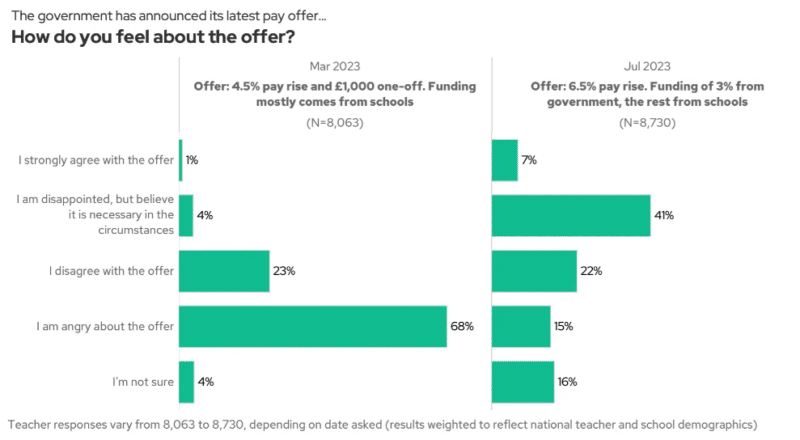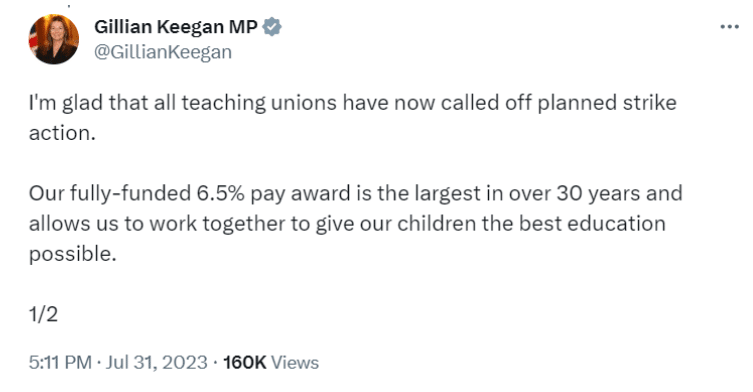Teacher Pay Award 2023 – August 2023 Update [Archive Reference Article]
Contents
England Teacher Pay Award – August 2023 Update
[Archive Reference Article]
On 13th July 2023, the Government and four main teaching unions released a joint statement after the publication of the School Teachers’ Review Body (STRB) recommendations for a teacher pay award for the academic year 2023-24. The STRB had recommended that the government increase pay for teachers and school leaders by 6.5%. The four teaching unions (NEU, NASUWT, ASCL and NAHT) had previously been in dispute with the government after rejecting an average pay offer in March of 4.5% and agreeing to adopt a united front in the pay campaign. In the joint statement of 13th July, the executive leadership teams of the unions said that they would put the pay deal to their members, recommending that it be accepted.
At the same time, unions were also in the process of holding a separate ballot for industrial action in the Autumn Term related to the pay dispute. Many members had already submitted their responses prior to the announcement on 13th July. In essence, union members now had to vote on two separate issues:
1) Did they agree with the recommended 6.5% pay offer?
2) Were they prepared to take industrial action including strikes in the Autumn Term if the dispute continued?
What were the outcomes of the ballots?
Each union put the ballot questions to their members in slightly different formats and the final results were announced on 31st July. The outcomes of each ballot are detailed in the table below.
Taken as a whole, this now means that the pay disputes for 2022-23 and 2023-24 have now formally ended with unions accepting the teacher pay award and proposals put forward. It is worth remembering that the NEU industrial action taken during 2022-23 was in relation to the 2022-23 teacher pay award. The electronic ballots recently held are in relation to the 2023-24 pay award which was recommended and accepted by all four unions.
Prior to the ballots taking place, a poll by Teacher Tapp gave an indication of how the pay offer was perceived by the profession. As their own commentary says, teachers had moved from being angry to disappointed.

What would have happened if the pay award had been rejected?
The government had accepted the pay recommendation by the STRB and therefore in theory, the 6.5% pay rise would have come into force in September 2023, regardless of whether the pay offer was accepted by union members. Given that the NEU, NASUWT and NAHT had voted in favour of industrial action and met the legal threshold for this, a period of joint industrial action would have also been possible if the pay award had been rejected.
How will my pay change?
The government has provided an online calculator for individuals to calculate the change to their pay here – https://www.gov.uk/guidance/calculate-teacher-pay
For illustrative purposes a teacher moving up to M4 teaching outside of London would see their pay increase to £36,051. This has risen from £33,850 (an increase of £2,201) which would work out to be an extra £183 per month before tax.
The first pay increases will take place in September 2023.
What happens to TLRs and those on the leadership scale?
Those receiving TLR payments should also find these increase by 6.5%. The same is true for those on the leadership scale.
What does the pay offer mean in real terms i.e. adjusted for inflation?
The unions had been campaigning for a fully-funded inflation-plus pay increase. Inflation measured by the Consumer Price Index (CPI) from September 2022 to June 2023 has averaged 8.68%. The accepted pay rise of 6.5% means that in real terms i.e. adjusted for inflation, the pay award is in fact a pay cut of around 2.1%.
How does this affect me if I work in an academy?
Whilst academies are not bound by the national pay scales, it is expected that academies will follow suit and increase pay by 6.5% also. Some have said that they will be awarding amounts larger than 6.5%.
What about support staff?
Support staff are not covered by this pay dispute as they are paid through a local government process and are also members of other unions including Unison.
How does the pay deal compare to those in Wales and Scotland?
One of the key arguments made by unions was that the English pay deals fell short of those made in other home nations. Broadly speaking, the English pay offer is similar to one that Welsh teachers accepted earlier in the year but is significantly below that of Scottish teachers. The table below gives a direct comparison.
*Scotland pay year runs April to April and figures quoted are for salary from January 2024.
Is it fully-funded?
A key tenet of the campaign was that any pay rise should be ‘fully-funded’ without schools having to find any money from their budgets to fund any pay increases. The issue of what counts as fully-funded has been a contentious part of the dispute. Simply put, the new pay deal is not fully-funded in the way that unions were campaigning for. However, it should be noted that the nature of school funding is complex and different arguments can be made as to how fully-funded the pay award is. In the agreed statement between the unions and the government, a compromised term of ‘properly-funded’ was used to describe the funding arrangements. The Secretary of State has since referred to the new pay deal as being fully-funded.

How is it funded?
The 6.5% pay increase will cost £1.6 billion in total for mainstream schools that implement the award and will be funded from a number of sources. 3% of the 6.5% will come from savings and efficiencies from within the existing Department for Education budget. The government has said that no money will be taken from frontline services to fund this element. The remaining 3.5% will come from within existing school budgets. This is why some are arguing that the pay award is not ‘fully-funded’. Union leaders have said that most schools had been budgeting on the assumption of having to fund a 3.5% increase from existing budgets so will have planned for this. It should also be noted that these figures are based on averages and there will be some schools that are disproportionately affected. A £40 million hardship fund has been created to help those particular schools.
What about the 2022-23 pay deal?
Whilst the dispute originated over the 2022-23 pay deal (5% increase in September 2022), it morphed into a wider dispute over pay which included the 2023-24 pay deal and how this might be funded. In March, the government made an offer to increase the 2022-23 pay deal by a one-off unconsolidated payment of £1000 in addition to increasing pay in 2023-24 by 4.5% on average. The government said that this was a final offer and if rejected, the £1000 payment would not be awarded and that the 2023-24 pay award would be in the hands of the STRB. This was put to union members and rejected by all four unions. As a result, the 2022-23 pay offer has remained unchanged since the start of the year with salaries having increased by 5% in September 2022 compared to the previous academic year. The new agreement on the pay award formally ends the 2022-23 dispute on pay.
Is this the end of industrial action for the foreseeable future?
The results of the ballot and comments from union leaders indicate that strike action will not be taking place in the Autumn Term. The only noticeable difference is from the NASUWT who commented that if ministers didn’t deliver on workload promises, their members may take action next term although the details of which are unclear at present.
Whilst the ballot results end the current dispute, it is clear that there is still strong feeling within the union leaderships that more must be done to increase teachers’ pay, school funding and address workload issues. If perceived progress on these areas are not made this year, the 2024-25 pay offer will provide the next opportunity for another formal dispute to begin with any industrial action likely to take place in September 2024.
When will the 2024-25 pay deal be announced?
The School Teachers’ Review Body (STRB) typically makes its recommendations to government in May with the government responding to these before the end of the Summer Term. The Secretary of State said that they would look to streamline this process next year to help with school budgeting decisions which could mean that these announcements come earlier.
The information contained within this article is not a complete or final statement of the law.
While Edapt has sought to ensure that the information is accurate and up-to-date, it is not responsible and will not be held liable for any inaccuracies and their consequences, including any loss arising from relying on this information. This article may contain information sourced from public sector bodies and licensed under the Open Government Licence. If you are an Edapt subscriber with an employment-related issue, please contact us and we will be able to refer you to one of our caseworkers.
